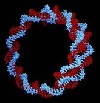Aspects of Chimeric Artificial Plasmids
Consequences of Circular DNA Molecules
By: Jimmy Midnight - Mar 02, 2013
Discovering a possibly damaging specific problem in transgenic crops.
I’m Jimmy Midnight. Although I do not have any advanced academic degree, I’m a longtime student of a group of subjects that could collectively be called, “Molecular Biology,” at about the level of a recent college graduate with a major somewhere in this molecular biology complex.
For the last few, maybe several months, I’ve been up on the internet, doing readings in this area, hoping that my “fresh eyes,” which are also those of a rock’n’roller and a visual artist, might see something that regular scholars are missing.
I wanted to be more literary about it all, and find some great principle in it, but now I’ve come to something very explicit, very specific. And it’s something I feel called upon, immediately, to share with other scientifically aware people, right now in the pre-dawn of another Northern Hemisphere growing season.
In creating the chimeric artificial plasmids that are the “vectors” of transgenic events, investigators/inventors are using circular DNA molecules that, as it turns out, can’t be fully digested by the usual array of pancreatic nucleases, because, since they’re circular, there are no free 3’ ends, deoxyribonuclease substrates, on them.
Okay, before winding this up, I’ll gladly stipulate that what I’m outlining here is working hypothesis, but it strikes me that it would be relatively easy to show—or not—in reasonably simple experimental protocols.
Now, these differentially less digestible circular DNA’s—some of which remain whole--become free-running or rogue chimeric artificial plasmids, free to roam, at least in the Brownian motion sense. Most of them will, of course, roll on through the digestive tract; but, in the biological world, there is what I’d call, “The Rhubarb Effect.” It’s about the tendency to recapitulate, easier and easier, biological events that have ever been consummated, as when seed-grown rhubarb plants throw new seed-stalks at a far smaller size than do divisions. Analogously, plasmids that already have made intergenonic jumps, are likely to be able to make additional intergenomic jumps.
Now these free-running chimeric artificial plasmids are able to invade micro and macro genomes of various kinds, which explains how various expressions of the various chimeric genes end up in tissues, internal microflora, and so on, as anecdotal evidence, at least, already has it. Is there also some kind of novel pathogen getting around? At least one reputable researcher thought so recently.
For regular correspondents, just bookmark this so you can say you got it today. You’ll be the first, ‘cause I’d resent it if somebody else took full credit for this idea.
For putative scientific contacts, I’ll fill this out it greater detail…soon.


